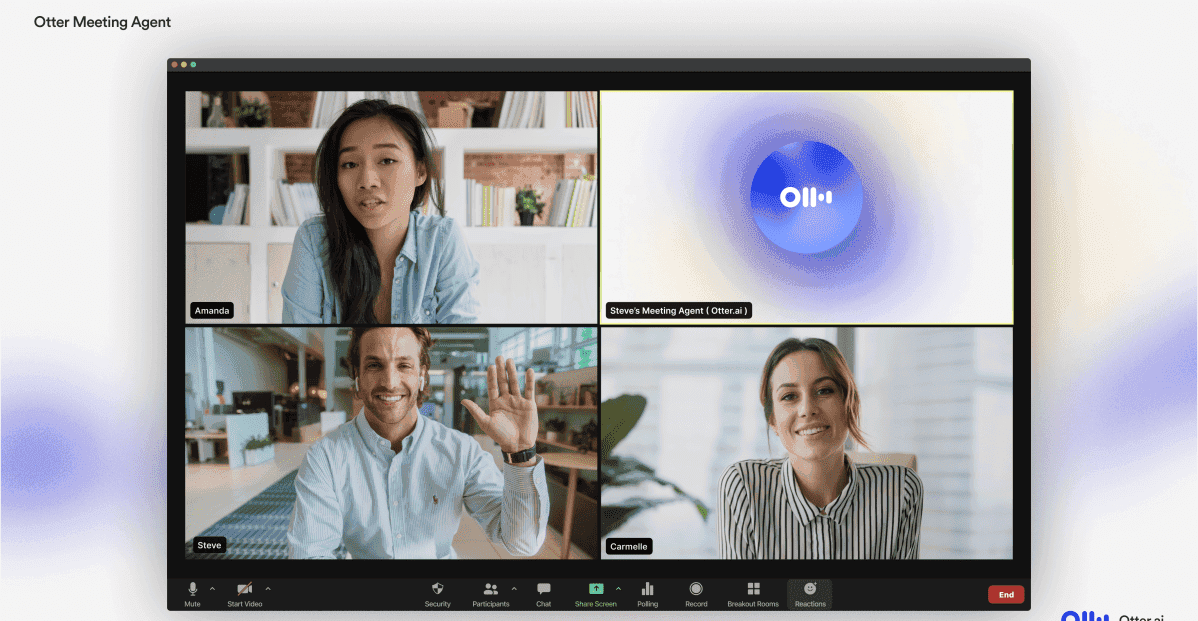Read AI Expands Beyond Virtual Meetings with New 'Operator' System for Real-World Conversations
2 Sources
2 Sources
[1]
Read AI is building a note-taking app that works nearly anywhere
You probably haven't heard of Read AI. The company has quietly been making a name for itself in the crowded AI space, signing up 50,000 customers daily in recent months. At first glance, Read AI resembles apps like Otter.ai. You can use the software to transcribe and summarize meetings, but it's also more ambitious than that. "It's AI on standby," Read AI CEO David Shim explains, adding that the company's vision is to give people a tool that can record, transcribe and analyze nearly every professional conversation they have, no matter where those discussions take place and whether they occur online or in-person. Today, Read AI is taking a major step toward realizing that vision with the release of its new Operator agent (I'll admit, the company could have picked a more original name), and new apps for Windows, macOS and Android. Between its own software, including an existing iOS app, and third-party integrations, Read AI users can now connect their accounts to more than 22 other platforms. Some of the more notable inclusions there are Gmail, Outlook, Slack, HubSpot and Notion. More importantly, with Read AI's mobile apps, you can record impromptu in-person meetings; the company has data showing that more than half of professional conversations occur outside of online spaces. In any case, no matter where you talk to your colleagues, Operator is there to generate notes and insights. "We don't just look at meetings," Shim says. "We look at topics that are interesting to you." To that end, Read AI has built a series of in-house multimodal models that look for context beyond what's said during any interaction you record. For example, the company's systems are designed to catch when you enthusiastically answer a question or look away in disinterest, and use that data to decide how the software goes about summarizing your meetings. "That context is what enables us to identify what is valuable to you, and make that discoverable," says Shim. One way Read AI will surface those insights is through a feature the company calls Monday Brief. At the start of every week, you'll get a summary of all the calls and conversations you had over the last seven days, with suggestions for follow-up actions you can take. Now, you might be wondering, like I was, how Read AI hopes to compete in a market where a company like Microsoft is aggressively pushing Copilot on its users. If Shim is worried about the big players, he doesn't show it. "There's a need for an independent third party," he says. "There's always something new coming out. And that ability to be the independent third-party that plugs into different solutions is actually what consumers want and need." To his point, since the launch of Copilot two years ago, Read AI has seen a 20x increase in the daily number of people using its software alongside Microsoft Teams. "We've seen the same thing along those lines for Zoom and Google Meet." He believes the company's approach to data privacy is another differentiator. By default, users are opted out of their data being used for training Read AI's future models. Shim also notes the company takes recording disclosure seriously. "You need to notify people that you're [recording] a call, and we put that front and center every single time." If you want to try Read AI, the company offers a free plan that includes five meeting transcripts per month. Pricing for its paid subscriptions start at $19.75 per month.
[2]
Read AI steps into the real world with new system for capturing everyday work chatter
Read AI, which made its mark analyzing online meetings and messages, is expanding its focus beyond the video call and the email inbox to the physical world, in a sign of the growing industry trend of applying artificial intelligence to offline and spontaneous work data. The Seattle-based startup on Wednesday introduced a new system called Operator that captures and analyzes interactions throughout the workday, including impromptu hallway conversations and in-person meetings in addition to virtual calls and emails, working across a wide range of popular apps and platforms. With the launch, Read AI is releasing new desktop clients for Windows and macOS, and a new Android app to join its existing iOS app and browser-based features. For offline conversations -- like a coffee chat or a conference room huddle -- users can open the Read AI app and manually hit record. The system then transcribes that audio and incorporates it into the company's AI system for broader insights into each user's meetings and workday. It comes as more companies bring workers back to the office for at least part of the week. According to new Read AI research, 53% of meetings now happen in-person or without a calendar invite -- up from 47% in 2023 -- while a large number of workday interactions occur outside of meetings entirely. In a break from others in the industry, Operator works via smartphone in these situations and does not require a pendant or clip-on recording device. "I don't think we'd ever build a device, because I think the phones themselves are good enough," said Read AI CEO David Shim in a recent interview, as featured on this week's GeekWire Podcast. This differs from hardware-first competitors like Limitless and Plaud, which require users to purchase and wear dedicated devices to capture "real-world" audio throughout the day. While these companies argue that a wearable provides a frictionless, "always-on" experience without draining your phone's battery, Read AI is betting that the friction of charging and wearing a separate gadget is a bigger hurdle than simply using the device you already have. To address the privacy concerns of recording in-person chats, Read AI relies on user compliance rather than an automated audible warning. When a user hits record on the desktop or mobile app, a pop-up prompts them to declare that the conversation is being captured, via voice or text. On mobile, a persistent reminder remains visible on the screen for the duration of the recording. Founded in 2021 by David Shim, Robert Williams, and Elliott Waldron, Read AI has raised more than $80 million and landed major enterprise customers for its cross-platform AI meeting assistant and productivity tools. It now reports 5 million monthly active users, with 24 million connected calendars to date. Operator is included in all of Read AI's existing plans at no additional cost.
Share
Share
Copy Link
Seattle-based Read AI launches its Operator system, extending AI-powered transcription and analysis from virtual meetings to in-person conversations. The company introduces new desktop and mobile apps to capture workplace interactions across 22+ platforms.
Read AI Launches Operator System for Comprehensive Workplace Communication
Seattle-based AI startup Read AI has announced the launch of its new Operator system, marking a significant expansion beyond virtual meeting analysis to capture and process real-world workplace conversations. The company, which has been quietly building momentum in the competitive AI transcription space, is now positioning itself as a comprehensive solution for professional communication analysis across both digital and physical environments
1
.Expanding Beyond Virtual Meetings
The Operator system represents Read AI's ambitious vision to become "AI on standby" for nearly every professional conversation, according to CEO David Shim. This expansion comes at a strategic time, as the company's research indicates that 53% of meetings now occur in-person or without calendar invites, representing an increase from 47% in 2023
2
. The shift reflects the broader trend of hybrid work environments where spontaneous, offline interactions play an increasingly important role in business operations.To support this expanded functionality, Read AI has released new desktop applications for Windows and macOS, alongside a new Android app that complements its existing iOS application. These tools enable users to manually record impromptu conversations, coffee chats, and conference room discussions that would otherwise be lost to traditional digital meeting platforms
2
.
Source: GeekWire
Comprehensive Platform Integration
The Operator system now integrates with more than 22 platforms, including major workplace tools such as Gmail, Outlook, Slack, HubSpot, and Notion. This extensive integration network allows Read AI to provide a unified view of professional communications across multiple channels, from email threads to video conferences to in-person meetings
1
.The company has developed proprietary multimodal AI models that analyze context beyond spoken words, incorporating visual cues such as enthusiasm levels and attention patterns to better understand meeting dynamics. This contextual analysis enables the system to identify valuable insights and surface them through features like the Monday Brief, which provides weekly summaries of conversations with suggested follow-up actions
1
.Related Stories
Competitive Positioning and Privacy Approach
Despite competition from tech giants like Microsoft with its Copilot integration, Read AI has experienced significant growth, with CEO Shim reporting a 20x increase in daily users alongside Microsoft Teams since Copilot's launch two years ago. The company positions itself as an independent third-party solution that can integrate across different platforms, arguing that this flexibility provides value that single-vendor solutions cannot match
1
.Read AI differentiates itself through its approach to data privacy and recording disclosure. Users are opted out by default from having their data used for training future AI models, and the system emphasizes transparent recording notifications. For in-person conversations, the app requires users to declare that recording is taking place, either through voice or text confirmation, with persistent visual reminders during mobile recordings
2
.Market Performance and Business Model
The company reports impressive growth metrics, with 50,000 new customers signing up daily in recent months and 5 million monthly active users across 24 million connected calendars. Founded in 2021 by David Shim, Robert Williams, and Elliott Waldron, Read AI has raised more than $80 million and secured major enterprise customers
2
.The company offers a freemium model with five meeting transcripts per month for free users, while paid subscriptions begin at $19.75 monthly. The new Operator functionality is included in all existing plans at no additional cost, making it accessible to the company's current user base
1
.References
Summarized by
Navi
Related Stories
Read AI Secures $50M in Series B Funding, Advancing Its 'Copilot Everywhere' Vision
28 Oct 2024•Technology

Otter.ai Introduces AI-Powered Meeting Agents to Revolutionize Virtual Collaboration
26 Mar 2025•Technology

Plaud Launches Note Pro: A New Era in AI-Powered Note-Taking Devices
28 Aug 2025•Technology








